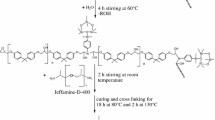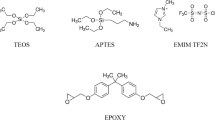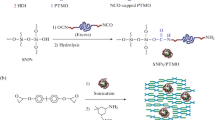Abstract
A series of silica–epoxy nanocomposites were prepared by hydrolysis of tetraethoxysilane within the organic matrix at different processing temperatures, i.e., 25 and 60 °C. Epoxy matrices reinforced with 2.0–10.0 wt% silica were subsequently crosslinked with an aliphatic diamine hardener to give optically transparent nanocomposite films. Interphase connections between silica networks and organic matrix were established by in situ functionalization of silica with 2.0 wt% γ-aminopropyltriethoxysilane (APTS). The microstructure of silica–epoxy nanocomposites as studied by transmission electron microscopy indicated the formation of very well-matched nanocomposites with homogeneous distribution of silica at relatively higher temperatures and in the presence of APTS. Thermogravimetric and static mechanical analyses confirmed considerable increase in thermal stability, stiffness, and toughness of the modified composite materials as compared to neat epoxy polymer and unmodified silica–epoxy nanocomposites. A slight improvement in the glass transition temperatures was also recorded by differential scanning calorimetry measurements. High temperature of hydrolysis during the in situ sol–gel process not only improved reaction kinetics but also promoted mutual solubility of the two phases, and consequently enhanced the interface strength. In addition, APTS influenced the size and distribution of the inorganic domain and resulted in better performance of the modified silica–epoxy nanocomposites.






Similar content being viewed by others
References
Kwon SC, Adachi T, Araki W, Yamaji A (2008) Effect of composing particles of two sizes on mechanical properties of spherical silica–particulate-reinforced epoxy composites. Composites B 39:740–746
Liu YL, Wei WL, Hsu KY, Ho WH (2004) Thermal stability of epoxy–silica composite materials by thermogravimetric analysis. Thermochim Acta 412:139–147
Chang KC, Lin HF, Lin CY, Kuo TH, Huang HH, Hsu SC, Yeh JM, Yang JC, Yu YH (2008) Effect of amino-modified silica nanoparticles on the corrosion protection properties of epoxy resin–silica hybrid materials. J Nanosci Nanotechnol 8:3040–3049
Yu D, Liu W, Liu Y (2008) Study on heat resistance and flame retardation of polyfunctional epoxy–silica–phosphorus hybrid resins. Chem Lett 37:1118–1125
Cardiano P (2008) Hydrophobic properties of new epoxy–silica hybrids. J Appl Polym Sci 108:3380–3387
Chen S, You B, Zhou S, Wu L (2009) Preparation and characterization of scratch and mar resistant waterborne epoxy/silica nanocomposite clearcoat. J Appl Polym Sci 112:3634–3639
Davis SR, Brough AR, Atkinson A (2003) Formation of silica/epoxy composite network polymers. J Non-Cryst Solids 315:197–205
Xiao F, Sun Y, Xiu Y, Wong CP (2007) Formation, thermal and mechanical properties of POSS epoxy composite composites. J Appl Polym Sci 104:2113–2121
Liu W, Hoa SV, Pugh M (2005) Organoclay-modified high performance epoxy nanocomposites. Compos Sci Technol 65:2364–2373
Bekyarova E, Thostenson ET, Yu A, Kim H, Gao J, Tang J, Hahn HT, Chou TW, Itkis ME, Haddon RC (2007) Multiscale carbon nanotube–carbon fiber reinforcement for advanced epoxy composites. Langmuir 23:3970–3974
Huang CJ, Fu SY, Zhang YH, Lauke B, Li LF, Ye L (2005) Cryogenic properties of SiO2/epoxy nanocomposites. Cryogenics 45:450–454
Mascia L, Prezzi L, Haworth B (2006) Substantiating the role of phase bicontinuity and interfacial bonding in epoxy–silica nanocomposites. J Mater Sci 41:1145–1155
Macan J, Brnardic I, Orlic S, Ivankovic H, Ivankovic M (2006) Thermal degradation of epoxy–silica organic–inorganic composite materials. Polym Degrad Stab 91:122–127
Tarrio-Saavedra J, Lopez-Beceiro J, Naya S, Artiaga R (2008) Effect of silica content on thermal stability of fumed silica/epoxy composites. Polym Degrad Stab 93:2133–2137
Adachi T, Osaki M, Araki W, Kwon SC (2008) Fracture toughness of nano- and micro-spherical silica-particle-filled epoxy composites. Acta Mater 56:2101–2109
Jiao J, Sun X, Pinnavaia TJ (2009) Mesostructured silica for the reinforcement and toughening of rubbery and glassy epoxy polymers. Polymer 50:983–989
Bugnicourt E, Galy J, Gerard JF, Barthel H (2007) Effect of sub-micron silica fillers on the mechanical performances of epoxy-based composites. Polymer 48:1596–1605
Brus J, Spirkova M, Hlavata D, Strachota A (2004) Self-organisation, structure, dynamic properties, and surface morphology of silica/epoxy films as seen by solid-state NMR, SAXS, and AFM. Macromolecules 37:1346–1357
Matejka L, Dukh O, Kolarik J (2000) Synthesis and characterization of organic–inorganic nanocomposites based on epoxy resin and 3-glycidoxypropyltrimethoxysilane. Polymer 41:1449–1459
Lu SR, Zhang HL, Zhao CX, Wang XY (2005) Preparation and characterization of epoxy–silica composite materials by the sol–gel process. J Mater Sci 40:1079–1085
Matejka L, Plestil J, Dusek K (1998) Structure evolution in epoxy silica nanocomposites: sol–gel process. J Non-Cryst Solids 226:114–121
Ochi M, Matsumura T (2005) Thermomechanical properties and phase structure of epoxy/silica nanohybrid materials constructed from a linear silicone oligomer. J Polym Sci B 43:1631–1639
Prezzi L, Mascia L (2005) Network density control in epoxy–silica nanocomposites by selective silane functionalization of precursors. Adv Polym Technol 24:91–102
Lu SR, Wei C, Yu JH, Yang XW, Jiang YM (2007) Preparation and characterization of epoxy nanocomposites by using PEO-grafted silica particles as modifiers. J Mater Sci 42:6708–6715
Matejka L, Dusek K, Plestil J, Kriz J, Lednicky F (1999) Formation and structure of the epoxy–silica nanocomposites. Polymer 40:171–181
Nazir T, Afzal A, Siddiqi HM, Ahmad Z, Dumon M (2010) Thermally and mechanically superior hybrid epoxy–silica polymer films via sol–gel method. Prog Org Coat 69:100–106
Jackson CL, Bauer BJ, Nakatani AI, Barnes JD (1996) Synthesis of hybrid organic–inorganic materials from interpenetrating polymer network chemistry. Chem Mater 8:727–733
Ochi M, Takahashi R, Terauchi A (2001) Phase structure and mechanical and adhesion properties of epoxy/silica nanocomposites. Polymer 42:5151–5158
Gu JW, Zhang QY, Li HC, Tang YS, Kong J, Dang J (2007) Study on preparation of SiO2/epoxy resin hybrid materials by means of sol–gel. Polym Plast Technol Eng 46:1129–1134
Mahrholz T, Stangle J, Sinapius M (2009) Quantitation of the reinforcement effect of silica nanoparticles in epoxy resins used in liquid composite molding processes. Composites A 40:235–243
Sun YY, Zhang ZQ, Moon KS, Wong CP (2004) Glass transition and relaxation behavior of epoxy nanocomposites. J Polym Sci B 42:3849–3858
Chen C, Justice RS, Schaefer DW, Baur JW (2008) Highly dispersed nanosilica–epoxy resins with enhanced mechanical properties. Polymer 49:3805–3815
Tjong SC (2006) Structure and mechanical properties of polymer nanocomposites. Mater Sci Eng R 53:73–197
Zhao Q, Hoa SV (2007) Toughening mechanism of epoxy resin with micro/nanoparticles. J Compos Mater 41:201–219
Acknowledgments
Financial support by the University Research Fund, Quaid-i-Azam University, Islamabad is gratefully acknowledged.
Author information
Authors and Affiliations
Corresponding author
Rights and permissions
About this article
Cite this article
Nazir, T., Afzal, A., Siddiqi, H.M. et al. The influence of temperature and interface strength on the microstructure and performance of sol–gel silica–epoxy nanocomposites. Polym. Bull. 67, 1539–1551 (2011). https://doi.org/10.1007/s00289-011-0495-y
Received:
Accepted:
Published:
Issue Date:
DOI: https://doi.org/10.1007/s00289-011-0495-y




